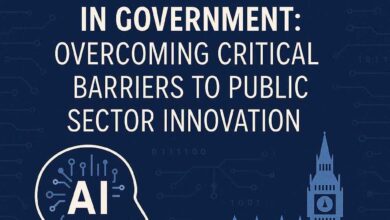
At the UK government’s February 2025 launch of its AI Playbook, technology secretary Peter Kyle issued a stern and urgent order to public sector technology specialists: “Use the guidance we are sharing to put AI to work in your organisations at whiplash speed, so we can repair our broken public services together.”
Barely one month later, Kyle was back behind the podium to announce significant changes to how AI experiments and digital projects within the public sector are funded. A new ‘test and learn’ approach, bolstered by more agile funding mechanisms, aims to enable technology specialists to build and test prototypes of AI-enabled services more quickly. Where early trials demonstrate potential for cost savings and improved public services, projects will be supported through incrementally larger tests.
But the effectiveness of this approach will be determined by more than just speed. It will demand an intelligent approach to connecting the vast volumes of fragmented data held across government. Without tackling legacy systems and data silos head-on, even the most promising AI initiatives risk falling short of their potential.
Early AI examples
With its talk of “test and learn” and the need to adopt a “start-up mindset”, the government is clearly looking to learn lessons from the private sector and apply them to the adoption of AI. This is in response to a government review that found that many digital projects within the public sector “face overly complex spending approval processes that can slow them down or prevent them from getting off the ground entirely.”
At the same time, it should not be overlooked that the UK public sector has already made significant moves in adopting AI. A number of successful AI examples now exist within government from which other departments and agencies might learn.
One of these is Redbox, a tool named after the iconic ministerial red box, which is designed to collate information on lessons learned from past projects and preserve knowledge that might otherwise be lost during staff turnover. Redbox enables ministers and civil servants to search for and consult government documents and generate more easily digestible summaries of complex papers and policies.
Another project underway within the NHS uses AI to prevent harmful prescription errors, highlighting AI’s dual role in delivering both cost savings and improving people’s lives.
Measuring improved outcomes
What is currently missing from the picture is a standardised, joined-up approach to quantifying the benefits of AI projects, both in terms of improved governmental efficiency and better outcomes for service users. With that in mind, it’s encouraging that the new ‘test and learn’ approach also includes a strong focus on developing new metrics to evaluate project plans to avoid wasting taxpayer money, and critically, to measure outcomes in terms of improved public services.
That’s a vital part of the picture, because positive outcomes for the public at large are essential to winning the trust of those who might be concerned about the technology’s risks or distrustful of the government’s intent in using AI. From the service-user perspective, a positive outcome will typically be perceived and defined as a faster, more convenient and less complicated interaction with the government, whether that’s registering a birth, applying for state benefits or renewing a passport.
It might be as straightforward as asking a simple question about their entitlement to social housing, for example, or whether they need to register their small business for VAT. Current pressures within the UK public sector mean they frequently experience prolonged waiting times and decision backlogs. The deployment of AI-enabled self-service portals could dramatically turn that situation around, making it easier for people to get answers to their questions and complete transactions at their own convenience.
In time, smart use of AI by public sector bodies holds out the promise of more personalised access to services. Take, for example, someone who needs to apply for social housing – depending on their accommodation needs, family circumstances and location, it’s a process that currently involves multiple steps, form-filling and in-person appointments. But if a local housing authority was able to use its own data as the engine of an AI-driven approach, that person might be able to find information and follow instructions based on their personal circumstances, reducing complexity and speeding up access to appropriate services in a more streamlined, relevant way.
Challenges ahead
Of course, there’s a major fly in the ointment here – and it’s one that the government readily acknowledges. This is the prevalence of outdated legacy systems in government.
The ‘test and learn’ approach explicitly takes this into account, prioritising AI adoption that will facilitate the replacement of outdated technology, following recent research that found that one in four of the digital systems currently used by government bodies is outdated and costs the taxpayer some £45 billion in lost productivity saving. In the worst affected organisations, according to the report, the proportion of outdated systems is more than one in three (70%).
“This outdated technology can rack up huge maintenance costs, ultimately resulting in the taxpayer paying out three to four times more than if the technology was kept up to date,” says DSIT.
However, this does not constitute a reasonable or economically valid argument to rip out and replace such systems wholesale. There are many ways to overcome these challenges using technology, enabling government departments to preserve existing investments and still deliver smart and efficient AI-enabled services. Where civil servants struggle daily with disconnected data, technical debt and interoperability challenges, what is typically needed is a way to aggregate data held in a wide range of disparate departmental and legacy systems so that it can be searched and analysed.
A centralised approach like this not only delivers a flexible and scalable way to get old and new systems working better together, but also ensures that existing rules around security and compliance are maintained and observed. When under-pinned by open source technologies, it can be cost-efficient, too. And, as new targets for AI enablement emerge, new analytical workloads can be developed and deployed incrementally.
There is still much work to be done – but the AI Playbook and test and learn approach both constitute encouraging signs that the government is committed to developing an AI strategy that ensures that public services truly deliver for people in the UK. Prime Minister Sir Keir Starmer has promised a “decade of renewal” and AI looks set to be a major factor in whether that will be achieved.





